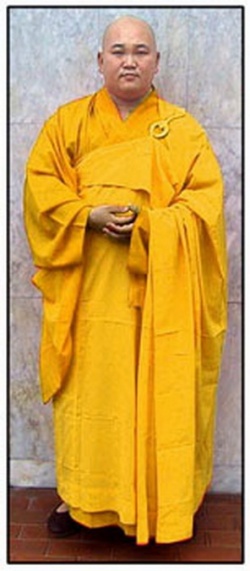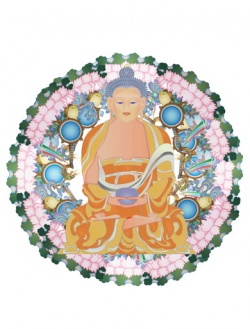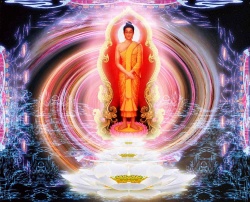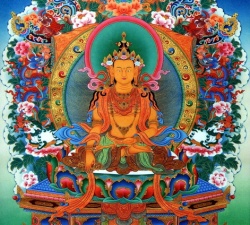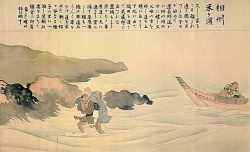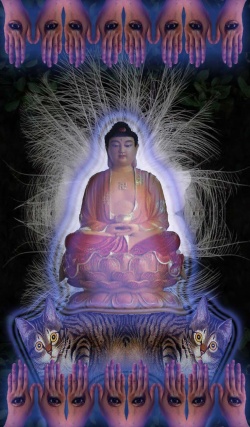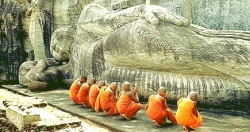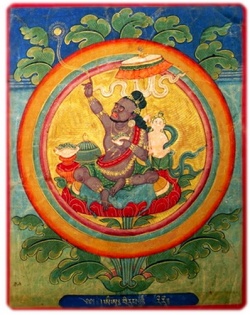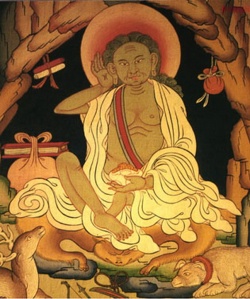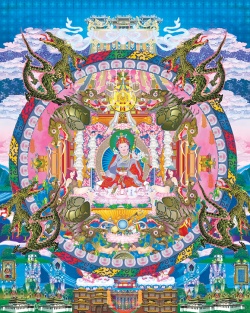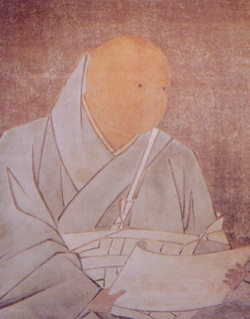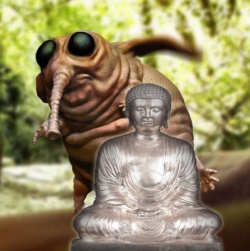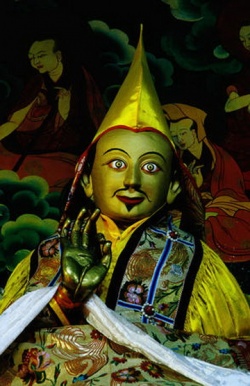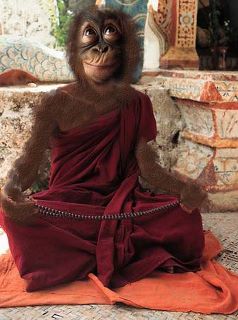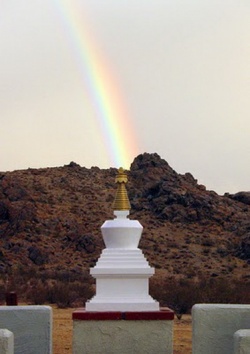Paticca samuppāda
Introduction
The twelve links of interdependent origination
- Dependent on ignorance (avijjā) mental formations...
- ... arise.
- From mental formations (saṅkhārā), rebirth consciousness arises.
- Consciousness (viññāṇa) gives rise to mental and physical phenomena.
- From mental and physical phenomena (nāma rūpa), the spheres of the six senses arise.
- From the spheres of the six senses (saḷāyatana), contact arises.
- Contact (phassa) causes sensation.
- Sensation (vedanā) leads to craving.
- From craving (taṇhā), attachment results.
- Attachment (upādāna) produces becoming.
- From becoming (bhava) birth arises.
- Finally, birth (jāti) leads to decay (jarā), death (maraṇaṃ), grief (soka), lamentation (parideva), pain (dukkha), sorrow (domanassa), despair (upāyāsa).
In this way the whole mass of suffering arises.
In reverse order...
- By the complete cessation of ignorance...
- ... mental formations cease.
- By the complete cessation of mental formations, consciousness ceases.
- By the complete cessation of consciousness, mental and physical phenomena cease.
- By the complete cessation of mental and physical phenomena, the spheres of the six senses cease.
- By the complete cessation of the spheres of the six senses, the contact ceases.
- By the complete cessation of the contact, the sensation ceases.
- By the complete cessation of the sensation, craving ceases.
- By the complete cessation of craving, attachment ceases.
- By the complete cessation of attachment, becoming ceases.
- By the complete cessation of becoming, birth ceases.
- By the complete cessation of birth, decay, death, grief, lamentation, pain, sorrow, despair (dukkha) cease.
Such is the complete cessation of this whole mass of suffering. The life process
Among all the things that the monk Gotama taught during his living, paṭiccasamuppāda takes part among the deepest, subtlest and most abstruse teachings and it is intimately linked with the idea of anatta, which means the absence of a "self", the absence of essential characteristics.
We can say that paṭiccasamuppāda provides the explanation of the process of anatta. anatta, this is an ineluctable reality, a universal reality, a completely timeless reality. We call this a "dhammata". We can say that paṭiccasamuppāda is the process that organises this ineluctable and unswerving truth, which is anatta.
Buddha, on several occasions, in a few suttas taught this doctrine of the interdependent origination. Noticeably, in one of these suttas, someone comes to ask him: " You assert that there is no reincarnation, your teaching doesn't include the belief in the cycle of reincarnations, but you however talk about past lives, future lives, you talk about rebirths. " The only answer given by Buddha is the exact list (above mentioned) of the twelve links that integrate this process in right and reverse order alike. This is the point where Buddha sums up his vision of what we call rebirths.
Indeed, this process is nothing else than a process, that is to say a series of events that appear out of necessity without the intervention of a factor or a being. This is therefore a totally uncontrollable, ineluctable and non-reversible series except, admittedly, in case we achieve the complete cessation of this process.
By definition, it is a totally uncontrollable process. It is in fact this process that controls, we could say, the evolution of matter, of its phenomena and the evolution of the mind, of its properties. All phenomena likely to be known by consciousness comprising consciousness itself, are indeed governed within this process itself. The fundamental, unswerving and primal law, this is anatta, which manifests within this process, which is therefore ineluctable.
The basic unity
The elementary unity of consciousness can have a life span that can perhaps be numbered in billionths of a billionth of a second of a second or even in thousandths of a billionth of a second. Thus every second is constituted with 1 000 000 000 000 or 1 000 000 000 000 000 000 elementary particles of consciousness, or even elementary moments of consciousness. Any of these moments does bear the specific character to rise and to pass away immediately according to a process which is paṭiccasamuppāda.
The succession of a very large number of units of consciousness constitutes a cycle, these units of consciousness being themselves some elementary cycles. The resulting cycle is governed by the law and the principle of paṭiccasamuppāda. The cycle itself takes part into the constitution of cycles, which are located in a superior sphere. These latter are governed by paṭiccasamuppāda.
As an example; Let's evoke an atom, which constitutes a very tiny quantity of known matter. Atoms' collection constitutes what we call a molecule. Molecules' collection can constitute what we call a cell. Cells' collection can constitute what we call an organ. Organs' collection constitutes what we call a human being or an animal. Humans' gathering constitutes a community, communities' assemblage constitutes a nation, etc.
We can also make use of a metaphor referring to the time issue: There are seconds that constitute minutes, these latter constitute hours, constituting days, the changing cycles of day and night and of days and nights are based on the lunar and seasonal cycles etc.
Each of these cycles, whether from the most elementary or else broadest view point that we could ponder over, as humans, and that we term the life cycle that starts with germination, that is to say impregnation and that ends with what we call decease, death. This cycle, which is the largest we could comprehend, is itself subdivided between numerous cycles, numerous alternations. Each of these cycles, of these sub-cycles, of these "sub-sub-cycles", is constituted with, participates and pertains to what we call paṭiccasamuppāda.
There was once, in Myanmar (Burma) a Venerable expert in giving talks on paṭiccasamuppāda. He succeeded in working out this analysis at its different levels of abstraction, at its different layers of manifestation. I am unable to do it as nicely as he did, but I will try to stress out an essential point of this process which is within my depth and I sincerely hope that it will be within yours too...
How is this process in line with life?
The absence of reincarnation
Through this given account, let us try to better understand how Buddha, this monk, reached the explanation, the suggestion that the reincarnations cycle and the notion of emanation are both empty of self inherent reality. He tells that these latter are absent from the universe.
Let's back up with a tangible fact that, at a specific moment, we do perceive. For example, a pain manifests in the foot, a violent pain. What is going on? Usually, for most of us, this pain calls for the expression of anger. When someone treads on our toes inside of a metro, rarely indeed does manifest within us a compassionate spirit, permeated with love, a fully opened and lucid state of mind. Most often, what does appear is rather a mind defiled with anger, hatred and aversion. It can further lead one to harsh speech, or even a rude gesture.
Here we find, in a very simplified way, an unfolding process: A harmful state of consciousness occurs. Hence, a displeasing sensation is experienced and manifests along with this harmful state of consciousness. At this very moment, anger manifests. We don't know why or how it does occur, but we have all experienced it: this is an almost automatic process. Following the occurrence of this anger, there is an intention, of a rather malevolent nature, which, sometimes doesn't develop any further, sometimes comes out in the shape of a sentence that could be: "You could have minded your gestures!" or "You ought to apologise at least!" or else in a ruder manner: "You idiot!" or anything else whatsoever.
It can even go further, we can make an aggressive gesture out of anger or even in order to avenge ourselves, in order to deal the person a blow with the feet or else to knock him or her about. Whereas it is pretty sure that the person who trod on our toe didn't do it on purpose at all.
So herewith is explained in a very concise manner this process: A consciousness appears, for example: a harmful state of consciousness that will soon give rise to a material phenomenon (for example: a hand movement, the utterance of a sound in the shape of a harmful speech). This is the way it works into what we call the universe, the conscious world. This is the way it works for all beings, at all time. Only the terminal stage
Everything that we can think, tell or do, is the terminal, visible, thought about, studied stage of a process that started prior to it, out of a mere conscious drive, out of a sensuous perception.
For example, we are reflecting upon the musical composition of Jean-Sébastien Bach by telling ourselves: "He is a wonderful composer, definitely inspired by a mystical impulse..." We can even talk about it with somebody. If we do all this, it is owing to the simple fact that inside of the metro, of the plane or the bus, we heard for a short while a radio broadcasting a melody of Jean-Sébastien Bach. Everything that occurred is a mere apparition of an auditory consciousness, along with a pleasant sensation, which gave rise to an passionate emotional reaction, etc.
It is exactly the same process as the one that can incite us to argue in a police station because we slapped someone, because we were very angry, because he trod on our toes, etc. We talk about life, about existence, the various parts of a day, by telling: " I eat, I watch the television, fine! Such political party has been elected, France won the football world cup... " All these things, this daily routine of mental idle talks or else shared with others through articulated speech is, in a broad sense, the last stage of this process.
Usually, this is the stage to which we dedicate the most of time; it is the discursive thought process. This is the stage to which we attach the most exhaustive investigations or reflections. It is quite rare that comes to our mind the idea of observing or knowing the previous stages. Sometimes, we can tell to ourselves: "I am aware that existence is the way it is, I am aware of suffering, these thoughts are always plaguing me." Nevertheless, we neglected, inadvertently, due to inattention, or let's simply say out of ignorance, to be concerned with what previously occurred and that now ends into this intellectual or philosophical speech. We missed the previous stages, such as the gum movement, the air circulation that enables us to speak, to therefore emit a sound. This is something we don't observe, because we are mentally absorbed into our speech.
Observing the previous stage, that is to say a pleasing or displeasing sensation, which has been produced by a sensory contact (a sound for example). If we reflect a bit upon it, we can actually understand, perceive that as soon as, during the day time, we dedicate some moments to a reflection upon life, about its unsatisfactory nature, about so many problems we have to face... Always also occur some moments when we are having a delicious drink, a delicious meal. At this moment, we instead start to think about "how lucky we are to be born in France, which is a country so famous for its art of entertaining and food." Unfortunately, we are pulled apart between thoughts' processes rather rooted in ideas that we like to call negative, and thoughts' processes rooted in rather positive ideas, we are permanently swayed apart between one and the other.
However, we fail to observe all the process that led us to the elaboration of what we call, in a broad sense, a conception, an idea, an ideation: Time, religion, philosophy, politics, work, family, society... As long as we maintain ourselves at this level, which is only the top of the iceberg, all these things are endowed with a certain value, a certain existence, a certain truth, but this is only the most inessential part of a compound of sub-cycles, sub-sub-cycles, sub-sub-sub-cycles, etc. about which, admittedly, we have been totally unaware. The thirst
And so, in life, as the philosopher Spinoza well brought to our ackowledgement, there is always a "thirst". That is to say a desire, a tendency. In Pali language, we say tanha. tanha, this is what projects consciousness onto its object.
Let's take the example of a pellet of bread that the children like to throw on the glasses. They make use of a blowpipe made out of a hollowed out ball point pen, and so they throw up some bread pellets against all sorts of things, usually where it is forbidden. The fact that the bread pellet is literally thrown up against something and finally gets pasted against the glass exemplifies tanha, which is this constantly nurtured, we could say everlasting drive, which permeates the mind when it projects itself unto an object. As soon as consciousness has appropriated an object, it will revel in it, as needless to say, our desires' main concern is usually pleasant things.
We project ourselves onto something, we find for ourselves a way to a destination that will give us a certain form of pleasure. This faculty to remain fixed on our object of pleasure is called " upadāna", which is the fixation. This latter is exemplified by the above mentioned example of the pellet remaining pasted against the glass, until it dries out and therefore slides and comes out. It will be needed to project the next pellet, in order to prolong the game.
In the same way in our daily life, at any specific moment we have a project, which in fact is a desire. It can lie in going to eat a tasty dish, going to watch something pleasant or to listen to some music. We are able to endure that which is at the depth, the most unbearable thing to endure in human life: Everyday life.
We are able to work out a considerable number of strategies, projects, steps, which we call administrative, professional, social, etc. having the sole aim, as obviously there is no other, to live our life. That is to say the one lying in making sure that the moments of pleasure will follow one other in as large quantities as possible, possibly at a high speed rate, and also that the moments of displeasure and pain will come in as small quantities as possible, and as short and as least frequent as possible.
This is the way we live. This is what we call human life. But however, in order to stay alive, there is what we call vital needs. These needs do not necessarily correspond with this idea of desire and attachment or of fixation, as besides, they are very often perceived by us to be chores. As we inevitably need to satisfy these needs, as this is the way the biology of our body functions, we will admittedly try to make out of these basic needs, as much as we can, moments of pleasure.
The interdependent origination is a process that follows itself, which is a kind of cycle that ceaselessly repeats itself. Exactly in the same way as a clock moves from the right to the left, and as long as the spring is tight, that is to say as long as there is still some energy left inside of this spring, the clock will keep on swinging. This "fuel" that is found inside of the spring, it is precisely tanha. This is truly speaking life's driving force. tanha, which is the word used for designating in a broad sense greed, desire, the inclination. And so, from the very beginning we find ignorance, a failure to know, an incapacity to know, an incapacity to be aware of, for example, what this pain that just appeared and its concurrently manifesting consciousness truly are. Because there is this incapacity to know this consciousness that just appeared, there does therefore occur this ignorance that, at this very moment, gives rise to what we call a mental formation.
Here, we will say that the formation that manifests along with the state of consciousness is, on one hand, this (pleasing or displeasing) sensation and, on the other, that need we have, at this moment, to perform an action.
It is not something easy to explain because paṭiccasamuppāda is a bit like a snake that bites its own tail... When we back up with these twelve elements, we can, to some extent, explain it by reversing its order. The order is not that important. It would be quite unexpected to teach paṭiccasamuppāda by changing the "squares", but we find something so peculiar within the phenomenon of apparition of consciousness that it shouldn't be a totally inaccurate thing to do. In the sense that it is a brief cycle and it is in line with the apparition of a first level phenomenon, itself constituting through its numerous repetitions a phenomenon of a higher level.
In order to simplify; let us say that from the start there is a defective knowledge of what really happens to us precisely at the moment when it does occur. Through this knowledge, there is immediately a pleasing or displeasing sensation. And so on, there will be a reaction, that is to say the apparition of an intention of project, which will usually be motivated by a desire to satisfy something. Then, once the object will be reached, it will give rise to a fixation on this object. We do appropriate this object, therefore a feeling of attachment is produced.
When a child gets angry, at the beginning, he knows why. He has fallen out with an adult because his toy has been taken away from him. Due to this continuous state of anger, he will end up literally sticking to that in his own mind. After some time, he will keep on crying, he will keep on making a whim whereas he will have totally forgotten the first cause of it. It often occurs this way. Addiction
At the outset beginning, we project ourselves onto something. Then after some time, mostly because it has become an addiction, we will revel ourselves in this situation, whereas the primal impulse that led us to this stage has already vanished since a long time. We won't even really know why it is so. That is attachment. Attachment is this faculty by which we indulge in our objects or speech. There is attachment to our views and beliefs, for example, a Christian or a Buddhist are very attached to their conceptions and views. Often, they no longer even know why. Often, it is owing to being born in them, these "things" have been narrated to them since early childhood, so they finally believe in them. Then they get attached to them and owing to this attachment to these views, there does manifest a constantly renewed thirst for worldly existence.
Attachment is that thing that makes our mind being literally fixed on and grasping at things. We also get attached, admittedly, to this idea of becoming, that is to say this thirst for life, this concept of being. We do believe in "being", we believe that we are and we are very attached to that. Not only in the conception ( I am a man, I am a woman, I am Paul, I am Peter, I am Buddhist, I am Christian, I am an atheist) but merely in the fact.
It is a very specific way to comprehend our reality, our inner truth. The fact to be, the fact to become, is something linked with that which we are totally fixed, totally stacked. It will give rise to numerous moments of apparition of tanha. That is to say it will constantly lead us to a new plan, a new initiative, a new step. At the outset, the main aim lied in maintaining and promoting this fixation. We don't want to experience a different state of mind. We believe to be a man, or a woman, and we are getting attached to this idea. We are going to perfect, to complete, to realize the status of "man", throughout observance of our customs, virile attributes such as perfumes, a way to comb our hair, to behave, etc. The same thing applies to women who get attached to this idea of womanliness, that is to say female in herself, this state of "being a woman", which will manifest in the same way through an art of clothing, of perfuming oneself, etc.
The attachment to the deity
For some of us, it is not the most important thing, there is something else. We can get attached to one of these most alienating, dangerous and pernicious attachments to be, which is the attachment to the deity, to "buddhahood". That is to say the absolute and transcendent stage of being. This state of being where precisely these basic or elementary notions of man, woman, society or culture have been supposedly transcended.
The attachment to the deity can manifest in the shape of conceptions, beliefs, that is to say, the attachment to the state of this self-existing entity, which is ineffable, eternal, immutable, spotless, pure, undefiled. We thus conceive an original consciousness, a consciousness "overall", which is transcendent, devoid of object, property, attribute and state. It would be about a consciousness which would be its own immutable object. This is the absolute fantasy of all mankind! We probably failed to beget, among our philosophical systems and among our loftiest religions, something higher and more crazy than this.
We also find the concept of this deity, the attachment to the realisation of this deity. It is easy to raise criticism about the so called materialists who try to reach in their own way a certain form of achievement. For some of them, the achievement lies in being appointed Chief Executive Officer in such and such company, Minister or President of a Republic. In fact, the step that incites us to start up a spiritual quest with this idea to reach the deity or "buddhahood", that is also a desire, a form of mental attachment, a fixation on the realisation of a STATE. For several moral, traditional, philosophical reasons, we believe this stage to be superior to the STATE of the President of a Republic or else...
At last, there is also the fixation as a direct identification with the divinity. It occurs when the divinity, "buddhahood" or the complete immersion has effectively taken place.
What is life really like?
What am I here to do?
It seems that the peculiar way the monk Gotama explained life to us along with its chains of events, is extraordinarily coherent. It is logical, healthy, simple, honest and, let us simply say, reasonable. It even seems that, besides, after some studies have been done and a training into these exercises, which Buddha teaches, has been undertaken, we could reach the conclusion that it is the only one that is reasonable. Thus, in quite a concise form and, in an extraordinarily reasonable, thoughtful, earnest and honest manner, did he explain how life, existence do unfold.
By the way, he explains us what bogs us down into this life process. This question that we ask unto ourselves: "But am I here to do?" And so, what we are doing here, is merely having desires. We are here because we do have desires, we are the fruit of our own desires, of our own tendencies, or our own drives. For various reasons, having undertaken an intellectual, cultural, academic training, we start to concoct our thoughts about our raison d'être. Simply because this is what we nurture within our own mind, we do have this intuition, this quality lying in elaborating conceptions about life. We do reflect upon it within ourselves...
Thus we tread a step whose aim, ultimately when we think about it at the depth, wouldn't be different from proceeding from a specific operative mode to a superior mode. Finally, to proceed from a certain paṭiccasamuppāda cycle to a upper cycle. Therefore, for some reasons that lie within us, we do imagine that this latter is no more one (a cycle). We do imagine that there would be a kind of perfectly linear and transcendent continuity, that would be no more subject to a cycle.
The monk Gotama made a great discovery, he had an intuition of sheer genius. If that intuition took place, it is mostly owing to quite a tangible experience that he did, which is nibbāna. He has discovered that at the most, we do imagine within ourselves, we do idealize something that may be nothing else than another cycle of paṭiccasamuppāda. This is therefore governed by paṭiccasamuppāda. That is to say, the apparition, becoming, according to a series of stages very concisely summarized as follows: A contact, a sensation, a reaction, an impulsion, a volition, a consciousness, a movement, an action, a becoming. Spiritual experiences
Thus, the ones among these "great spiritual masters" who believe to have reached the deity or "buddhahood", most certainly had an experience but, as they often themselves claim, they will dedicate the rest of their life time to this deity or state of "buddhahood". They have been got on, they have had a contact, an experience, whose intensity of happiness, well being and pleasure is so strong, that the corresponding intensity of desire and drive that will project them to be experienced again is considerable. It is so tremendous that the intensity of attachment, which will affect them, will be huge. If truly speaking there is something transcendent within our spiritual experiences, it is the feeling of attachment that they beget within us!
Thus, the monk Gotama made a perfectly disconcerting experience. The experience he had goes against all the rest, and save from his own words, it is taught nowhere else. Not in Christianity, not in Islam, neither in any eastern or western philosophies, nor in what is called in today's world Buddhism!
He made an experience, which is so contradictory with everything known in everyday life, that it is illustrated in a quite interesting way: The day preceding the night when he reached this experimental stage, he had a marvelous intuition that he was about to discover something entirely new, something really revolutionary.
Being inclined towards such a strong endeavour, after years of tribulations, after years of experiences, among which precisely, these mystical or divine experiences, he just dropped his bowl in the river, which just flew beneath his feet, and told unto himself: "If I truly had something entirely new to discover tonight, something entirely new in this present world, may the bowl not follow the current but instead go against it! " This is what happened. It is irrelevant to be concerned with the legendary or miraculous aspect of that story. What is interesting is that it illustrates how far what Buddha discovered is absolutely revolutionary and contrary to everything that is known, everything that is established, everything that is taught, in the whole universe. What is it?
It is precisely this paṭiccasamuppāda in reverse order. The monk Gotama has made an experience, an experimental experience as he knew nothing of the theory backing it. He has made the experience of the reverse order. That is to say, at a given moment, he didn't fail to know what appeared to his consciousness, didn't forget to turn his attention to it and ceased to be ignorant.
The extraordinary thing that occurred is precisely that, this consciousness, this sensation, this contact and this object ceased to appear. They ceased to appear and at this moment did the cycle of apparition of consciousness and its object cease. There was therefore no further chain or sequence. This is impossible as an interruption took place. He experienced what we call cessation, cessation of non-knowledge, cessation of ignorance, cessation of the incapacity to know, which led to the cessation of that, precisely, which, once for ever, has not been ignored. The cessation of knowledge
That's why Buddha doesn't say: "The apparition of knowledge" He says: "The cessation of ignorance". As if he had told " the apparition of knowledge", it would have meant that prior to it we knew, we were comprehending phenomena with ignorance, then now, we would be able to comprehend the phenomena under the guiding light of knowledge. No, does he claim "there is a cessation of ignorance" because precisely there is a cessation of phenomena. If a phenomenon ceases to appear, how could we know it?
The main idea is not to comprehend phenomena surrounding us while cultivating knowledge. The main idea is that these phenomena that appear cease to appear, because owing to the cessation of their appearance, the consciousness that concurrently manifests ceases to appear as well. According to Buddha, this is precisely what we can call the cessation of ignorance. It is as silly as that, because upon hearing this, we could nearly claim that it is a bit foolish, sheer simplicity indeed! Whereas some people tell us about transcendent knowledge, about a mode of consciousness, that there is a consciousness being deluded in samsāra, and that there is a transcendent consciousness endowed with knowledge...
The experience that the monk Gotama has made is totally disconcerting, quite unbelievable. Besides, this question should no more be asked under beliefs' perspective. The cessation of ignorance necessarily manifests along with the cessation of knowledge. Only when there is nothing left to be known and there is no more knowing consciousness can we achieve the cessation of what Buddha calls ignorance.
nibbāna and parinibbāna
The apparition of consciousness
As soon as consciousness appears, there is forcibly a failure somewhere. Consciousness appears because somewhere there is a "fold". Consciousness appears because somewhere there is a relief. It appears along with its object because there is ignorance.
Buddha thus has experienced the cessation of consciousness and its object. This is the way, did he claim, leading to the end of ignorance. Obviously, it is a somehow radical process. It is not that much about an annihilation, an eradication, a total destruction. Simply, the consciousness that appears along with its object, according to a quite specific cycle of successive stages and chains of events (which will subsequently experience all kinds of angers, desires, greed), does no longer manifest.
Nevertheless, for some reasons quite difficult to explain and besides, it seems that they are not explained in the scriptures, from the moment when consciousness ceases to appear along with its object, it still takes an object that is nibbāna. It is a very particular process, it is unbelievable. Consciousness can but keep on appearing, even if there does remain no more object it can focus on, (admittedly, if there is no object at all, it is obvious that it cannot appear) it nurtures a kind of tendency that is so strong that even a tangible object, prehensile the way a sound is, does no longer appear, consciousness takes nibbāna for object.
An interesting discovery
This is where Buddha made an interesting discovery, he didn't only discover "nirodha", which is the cessation of the apparition of consciousness and its objects, but also this particular discovery that when all this ceases to appear, there does remain something else. This is not a hole, neither a nothingness, nor THE nothingness. Consciousness, which cannot do otherwise than sticking to its usual habits, will take nibbāna for object. But, the consciousness that takes nibbāna for object, is still being set in motion, admittedly, in the cycle of paṭiccasamuppāda. It appears, it vanishes, it projects itself unto its object, it sticks itself to its object, it grasps its object. Then it slides and disappears, so as to allow the following moment of consciousness to take place.
And so, when the yogī reaches nibbāna, contemplates nibbāna, Buddha tells that this consciousness, which takes nibbāna for object, is still an unsatisfactory, impermanent and totally uncontrollable fabrication. Nevertheless, if Buddha had neither seen nor perceived nibbāna, then how could he find out about its existence? nibbāna, it is something very specific. It would be vain to try to give a definitive explanation and description about it.
The specificity of nibbāna
The specificity of nibbāna lies in the simple fact that it doesn't appear. Nevertheless, the consciousness can take it for object, whereas it is devoid of any kind of asperity. The specificity of nibbāna lies in the fact that it can be known by consciousness as the consciousness that takes it for object can also totally vanish and disappear. We call this: parinibbāna.
This is what happens when the yogī has undertaken a training, by following the advises given by the monk Gotama, in order to know as much as he can, all the phenomena that appear to consciousness. All this so that, precisely, this ignorance that begot this apparition ceases to be and, from this very moment, consciousness takes nibbāna for object. From a certain viewpoint, it is not satisfying yet, because there is still consciousness that takes something for object.
Nevertheless, it makes a big difference. This object doesn't pertain to paṭiccasamuppāda. It is not an object that appears, which disappears, it is not a component object. It does possess no intrinsic quality, no intrinsic attribute, nor even extrinsic besides. It is formless, it has no corner stone, it has no asperity. It is something very specific. Buddha claims that it is empty. It is not EMPTINESS indeed, it is merely empty. As soon as consciousness manifests, there is a certain form of consciousness, a certain state of consciousness, a certain property of consciousness. A consciousness devoid of property... it doesn't exist.
Thus, when consciousness takes nibbāna for object, due to the absence of texture, the absence of nature, the absence of definition, owing to the fact that it does not appear, consciousness does experience no sensation at all. There is no sensation to be perceived. It is neither good nor bad, it is not neutral even.
We utilize a terminology that, unfortunately, is often misunderstood. (Every time Buddha uses a word, the benefit taken lies in that it suggests us something, the inconvenience lies in applying our limited conceptual categories to the meaning conveyed by this word); We tell "santi sukha". "santi sukha" means a pleasure that is the fruit of a peaceful state. What is peculiar is that consciousness which knows nibbāna does experience absolutely no pleasure at all. Precisely because, in nibbāna, there is nothing to perceive, nothing to know, nothing to hear and, by definition, it is inconceivable that there could be a reaction, an anger, a thought, a word or a movement.
Precisely because there is nothing to be seen and no sensation, does happiness arise, this famous "santi sukha". That is to say this "pleasure" that is owing to the absence of pleasure. This happiness, which is experienced precisely because there is no happiness, because there is nothing that can suggest a state of happiness. I sometimes utilise the terms: "It is about a happiness by contumacy."
This experience of nibbāna, Buddha has made it. Visibly, it didn't do him a lot of harm as he came back from it. He even successfully came back from it. He has perceived nibbāna, known nibbāna, observed nibbāna. Soon after having made this experience and developed the qualities peculiar to the monk and the yogī he was, which his successors, his disciples, won't be able to develop (noticeably a capacity to know all in all). He has, from this moment, naturally felt the need to do this experience again. He therefore remained immersed in the knowledge of nibbāna for seven days.
The final conclusion
At this moment, he understood that this consciousness that took nibbāna for object, although being peaceful by nature, is nevertheless... still here! He then made another experience, over the seven following days, he actually reached the cessation of paṭiccasamuppāda, the cessation of this cycle of apparition of consciousness and its objects and he succeeded in preventing consciousness from reappearing while taking nibbāna for object so that it totally ceases to appear. He did experience nibbāna without any kind of residual consciousness.
Owing to this experience he had, he reached the final conclusion that nibbāna is really the final, non-reversible and definitive deliverance. If he succeeded in perceiving nibbāna, knowing nibbāna, observing nibbāna, then how could he find out that it was the final end to all our problems, as it was still a stage of knowledge (of nibbāna)? There was still the apparition of a consciousness which feels, which examines. It is precisely when he reached this experience of nibbāna, a definitive one, devoid of any form of residual consciousness, that he understood thereafter that nibbāna is the end beyond contest. We should rather say the total and definitive absence of suffering. A total absence of suffering owing to a total absence of misfortune, hatred, anger, desire, joy, love or anything whatsoever, owing to a total absence of properties, consciousness, sensation, object, colouring and shape.
The direction of use
The monk Gotama has handed down to us a direction of use that we call dhamma, which is his teaching in a broad sense. The direction of use of what? The direction of use of that which will enable us to make this experience that we call nibbāna. He left the instrument to us. The instrument that is needed for reading this direction of use. The direction of use that he left to us is a bit likened to a CDROM: There must be a computer enabling us to read this CDROM. Likewise, in order to get access to a direction of use, one must have an instrument. This instrument, we call it saṃgha. The saṃgha is the prerequisite to the sake of preservation and transmission of the direction of use, which makes it accessible to all beings who are willing to take the trouble to practice and study it.
This teaching (dhamma), transmitted in today's world by what Buddha himself set in motion (the saṃgha), is the teaching that enables us to make this experience of what we call awakening. That is to say the cessation of this paṭiccasamuppāda, or else the interruption of this cycle, which is the cycle of suffering (dukkha). This teaching has been handed down to us, in our present age, in a seemingly good shape, but everything is relative. In all cases, it has been made available in today's world. We are very fortunate on this turn, but this teaching would be nothing if it wasn't studied, taught, understood and mainly... if it wasn't practised and realised.
see also:Dependent origination
